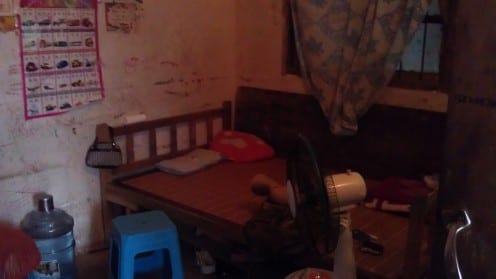Ceramics, forklift trucks and social media
By Xin Yuan Wang, on 20 October 2013
(By Daniel Miller and Xinyuan Wang)

A factory worker who is operating forklift truck in Xinyuan Wang’s fieldsite, and a 12-13th century Jingdezhen ceramics in the Shanghai Museum (photo by Xinyuan Wang)
For ethnographers working in the field of material culture, people’s values often ‘unintentionally’ reveal themselves in the tiniest of things. Similarly, a day’s field work may be crystallised by some seemingly random lines, or just a word. On this fieldtrip we both felt that a Chinese place name Jingdezhen (景德镇) on the label of beautiful ancient Chinese ceramics in the Shanghai museum somehow made us think about social media in a different way.
Danny’s visit to China started with seeing Tom in the North, followed by Xinyuan in the South, and ended up with a few days in Shanghai (near Xinyuan’s fieldsite). In the Shanghai Museum there are many examples of exquisite and delicate ceramics from one of the most famous pottery making sites in the world: Jingdezhen.
As we stood looking a delicate examples from several centuries ago, Xinyuan recalled that some of her factory informants who currently operate forklift trucks also come from this region of inland China. Furthermore, they used to work in these same ceramic workshops that still produce some of the finest ceramics in the country. This led to a discussion. Why would people who had previously been associated with one of the world’s finest artisanal products abandoned that craft in order to operate forklift trucks in a noisy and vast factory. What happened?
The key factor as Xinyuan’s informant HH told her was that “making pots is just so boring, sitting in the room, dealing with the mud day after day, and year after year.”
It is quite understandable that compared to designing, carving, or painting ceramics, making the bodies of the pot itself, which these workers used to do, is not that stimulating and interesting: it was as repetitious as the work on the assembly line in factories. However what makes such remark interesting is Xinyuan’s observation of her factory friends’ daily usage of social media via their smartphones in workplace. Xinyuan knows these drivers especially well because the demand on their work is intermittent, which means they have spare time in the day. Spare time with nothing to do might in turn have meant this was designated as more boring rather than less boring work. During these days they not only chat but also go online through their smartphones. So, in effect, the possession of a phone with social media can reverse the whole concept of work. What was once a sign of boredom as an interlude is now a sign that you can engage in the one thing that is pretty much never seen as boring, which is social media.
There is more to this. Social media here is not just defined as less boring because it gives you something to do. The way QQ operates is rather different from Facebook. It is full of pop-ups, multiple channels, which flow easily between looking up people, watching entertainment, gaming and other pursuits. It is a much more evidently exciting activity than Facebook. The material present there is fast moving, bright and modern. This is crucial to the larger and underlying study. Xinyuan’s study of QQ at this particular site was intended to represent the largest migration in world history of 130 million workers. But what Xinyuan has found is actually salaries are not so much greater than in the home lands of these workers and there is employment available to many of them there. Furthemore living in their hometown means greatly reduced costs, so reducing this migration to economic necessities may be quite misleading. It is rather that as people in local shops told us when we were chatting with them, this area, which is much closer to places such as Shanghai, seems more modern, with more potential for interesting lives and exciting times.
This in turn leads to one of the key findings about how rural migrants use social media. Xinyuan originally expected that the key would be the ability of social media to help people retain links back to their place of origin and their wider family. The assumption was that like most other migrations, today this was born of poverty and struggle. Having had to leave their family they would want to stay in touch. People do use social media for this purpose, but they are much more clearly orientated to developing connections in this new site. This is, after, all the main reason they have come: to see another ‘world’ and gain new experiences. So social media is much more about the plethora of new contacts and new people they meet. This is why social media so clearly represents that which is not ‘boring’: not the predestined fate of the past, and why QQ places more emphasis on being exciting and not just a place for social connectivity.
So, ceramics or forklift? Actually, this turns out to be only part of the question. Most of the time people’s choice was not based on the alternative between ceramics or forklift trucks. Rather the key is social media, which represents all the possibility and connectivity which they hope to develop also in their living context. Social media is much more than a technology, just as a place of living is much more than the job you do when living there.
 Close
Close








